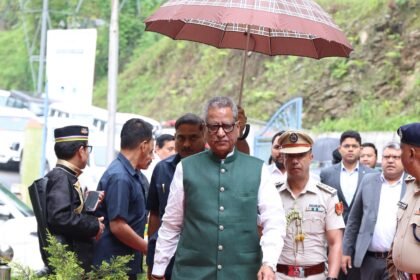In her keynote address during the State Disaster Risk Reduction Day programme on October 4 at Chintan Bhavan here, Ms Namrata Thapa, Relief Commissioner cum Secretary, LR&DMD, emphasised the State’s ongoing efforts toward disaster preparedness and resilience-building.She reflected on the importance of State Disaster Risk Reduction Day as a platform for collaboration, allowing stakeholders to come together to forge stronger systems that protect the people of Sikkim from the increasing threats of natural disasters, particularly in the context of global warming and climate change.
Ms Thapa highlighted the increasing risk of Glacial Lake Outburst Floods (GLOF) as one of the State’s most pressing concerns. She expressed deep gratitude to the Chief Minister for his unwavering support and leadership, which have been pivotal in advancing Sikkim’s disaster risk reduction programmes and strengthening the state’s resilience against environmental risks.
She reaffirmed that the Government of Sikkim has always been at the forefront of addressing environmental tragedies through proactive measures.She also underscored the cultural and environmental significance of Sikkim’s lakes, describing them as both natural resources and sacred elements embedded in the state’s heritage. While stressing the need to preserve their sanctity, she noted that these lakes could pose flood risks due to the effects of climate change. She further addressed the growing frequency of landslides and other natural disasters, highlighting the necessity of robust disaster management plans.Reflecting on the October 3-4, 2023 flood, Ms Thapa called it a stark reminder of nature’s power and the urgent need to safeguard lives and livelihoods.
She assured that the state government remains committed to mitigating the risks posed by GLOF and other climate-related threats through collaborative efforts across various departments.She then outlined the recent multidisciplinary efforts led by the LR&DMD, which, on August 31, 2024, conducted a hazard assessment of six high-risk lakes in the upper reaches of Mangan district.
This assessment involved five state government departments namely Science & Technology, Mines & Geology, Land Revenue, Water Resources and Forest & Environment Departments, central agencies such as the Geological Survey of India and the Central Water Commission, as well as Sikkim University. Support from the Indian Army, ITBP, and local bodies such as Lachung Dzumsa and Lachen Dzumsa was instrumental in the success of this mission.
Earlier, in June 2024, a similar survey was conducted in Gyalshing district. The data from these assessments will play a critical role in flood modelling and risk assessment, with reports to be submitted to the state government, she stated.She further highlighted the department’s ongoing community outreach programmes, workshops, and training sessions to educate people about GLOF risks and preparedness.
These initiatives aim to build local capacity, ensuring that communities are both aware of the risks and equipped to respond swiftly when needed.Ms Thapa further presented several key suggestions, including student engagement to foster disaster awareness from a young age, hospital preparedness to ensure swift medical responses during emergencies, and the readiness of government departments to act efficiently in times of crisis.
She also stressed the importance of involving local governance bodies, ensuring the convergence of state and central programmes, and strengthening civil defence mechanisms, among others.Mr Dhiren Shrestha, Principal Director, Science & Technology Department, Government of Sikkim, delivered a comprehensive presentation on the recent study of GLOF in Sikkim and the initiatives of the Government of Sikkim in addressing glacial threats in the state.
IPR Report





